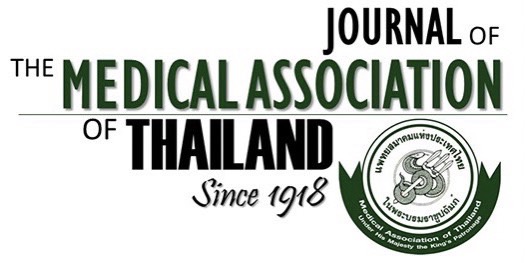Outcome of Myringotomy with Ventilation Tube for Otitis Media with Effusion in Thai Children: Ramathibodi Experiences
Kunchitthape Tanpowpong MD*, Intuorn Saisukul MD*, Hataikorn Kittimanont MSc**, Sasivimol Rattanasiri PhD***
Affiliation : * Department of Otolaryngology, Faculty of Medicine, Ramathibodi Hospital, Mahidol University ** Department of Nursing, Faculty of Medicine, Ramathibodi Hospital, Mahidol University *** Clinical of Epidemiology Unit, Faculty of Medicine, Ramathibodi Hospital, Mahidol University
Objective : Study the otologic and audiologic outcome when using a ventilation tube (VT) for the treatment of
otitis media with effusion (OME) in Thai children.
Materials and Methods : The medical records of twenty-three pediatric patients,17 male and 6 female, aged 4 to
11 (mean age of 6.8 years), with the diagnosis of OME who attended the Department of Otolaryngology,
Faculty of Medicine Ramathibodi Hospital, between January 2001 and December 2006 were reviewed.
Seventeen (73.9%) patients had associated diseases, 26% with allergic rhinitis (AR), 21.7% with obstructive
sleep apnea from chronic hypertrophic tonsillitis and adenoid hypertrophy (OSA), and 26% with cleft palate
(CP). The audiometric with tympanometric assessment were done pre- and post-operative with mean of 47.3
and 294.2 days respectively. All children were treated with myringotomy and insertion of VT. Oto-microscopic
examinations for tympanic membrane pathologic abnormalities were confirmed. Post operative otorrhea
cases were identified. The extrusion rates of VT were also recorded after the insertion.
Results : Twenty-three patients were enrolled in the present study. Mean air-bone gap was 18.24 (SD = 13.04)
and 10.83 (SD = 8.26) before and after the operation respectively, and the difference was statistically signifi-
cant (p = 0.0013). This could be interpreted that myringotomy with insertion VT could improve hearing by
decreasing the air-bone gap dB. Having assessed the effect of associated diseases (i.e., AR, OSA, and CP) on
differences of air-bone gap between before and after operation, the authors found that having AR, OSA, and
CP did not statistically affect the results of the operation. However, the mean differences of air-bone gap
between before and after operation were quite different for AR versus non-AR (-11.58 vs. -5.78), and OSA
versus the non-OSA group (-12.10 vs. -5.95). This might have the effects of the two factors but with this small
sample size and thus low power could not detect the effect. Tympanometric pattern was mainly type B in the
pre-operative (79.3%) and post operative (62.5%) period after tympanic membrane closure in both ears.
Mucoid fluid in the middle ear cavity of both ears was detected during the operation in all patients. Post
operative otorrhoea occurred in 16.7%.The mean of extrusion rate of VT was 307.2 + 204.7 days with maxi-
mum of 760 days. The mean duration of OME before surgery was 384.1 days.
Conclusion : The effects of conventional VT in Thai children with OME could improve statistical significant
hearing by decreasing the air-bone gap. The associated diseases (i.e., AR, OSA, and CP) did not statistically
affect the results of the operation.
Keywords : Otitis media with effusion, Myringotomy, Ventilation tube



